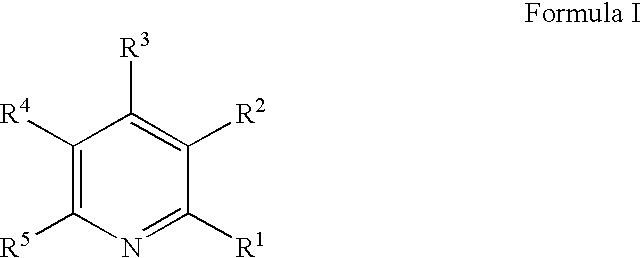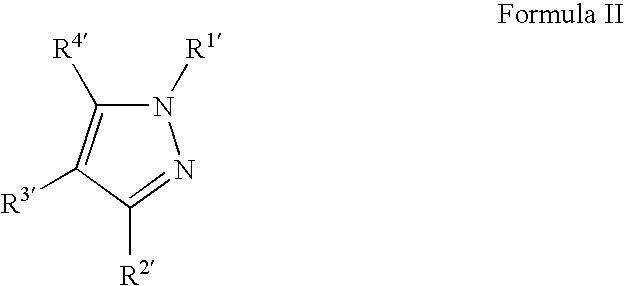Copper deposition using copper formate complexes
a technology of copper formate and complexes, which is applied in the direction of chemical vapor deposition coating, chemical/physical processes, textiles and paper, etc., can solve the problems of bulky tertiary non-aromatic nitrogen donor ligands (e.g., triethylamine) and unsuitable formulation for supercritical fluids
- Summary
- Abstract
- Description
- Claims
- Application Information
AI Technical Summary
Benefits of technology
Problems solved by technology
Method used
Image
Examples
example 1
Synthesis of Copper(II) Complex with 4-(5-nonyl)pyridine
Anhydrous copper formate (0.025 g, 0.163 mmole) was mixed with 5 mL methanol in a round bottom flask with a Teflon-coated stir bar. 4-(5-nonyl)pyridine (0.072 mL, 0.326 mmole) was added directly to the stirred solution. A deep blue color developed rapidly. The mixture was stirred for five minutes and filtered through diatomaceous earth to remove excess copper formate. The solvent was removed under vacuum to yield royal blue oil. Elemental analysis was consistent with the formation of Cu(4-(5-nonyl)pyridine).sub.2 (HCOO).sub.2.H.sub.2 O. Calculated: 61.88% C; 8.66% H and 4.81% N. Observed: 61.36% C, 8.76% H and 4.51% N. Infrared spectrum of neat oil shows stretch at .about.3350 cm.sup.-1, characteristic of lattice water (Nakamoto); 1600 cm.sup.-1 region obscured by 4-(5-nonyl)pyridine stretches.
example 2
Determination of Solubility of Cu(4-(5-nonyl)pyridine).sub.2 (HCOO).sub.2 Complex in Supercritical Carbon Dioxide
Solubility of the Cu(4-(5-nonyl)pyridine).sub.2 (HCOO).sub.2 complex described in Example 1 was determined with an ISCO Model 3650 SCF Extractor. The complex (0.70 g) was thoroughly mixed with diatomaceous earth (0.70 g) in a Vacuum Atmospheres dry box under nitrogen to yield a royal blue solid mixture. This mixture was then loaded under nitrogen into a plastic sample container for the ISCO Model 3650 SCF Extractor. Supercritical carbon dioxide at 2500 psi and 40.degree. C. was passed through the sample holder. A deep blue solution was recovered in methanol. The solubility was determined to be 4.3 wt % under these conditions. The instrument was programmed to heat the sample cell to 40.degree. C. and pressurize it statically for 10 min, then flow liquid CO.sub.2 feed through the sample vial at .about.1 mL (liq) / min. The amount of the complex removed from the vial during th...
example 3
Copper Deposition from Cu(4-(5-nonyl)pyridine).sub.2 (HCOO).sub.2 Complex under 1000 psi Carbon Dioxide
Deposition of copper from a solution of the of Cu(4-(5-nonyl)pyridine).sub.2 (HCOO).sub.2 complex described in Example 1 was determined in the following manner. The complex (0.25 g) was dissolved in 10 mL hexane in a Vacuum Atmospheres dry box under nitrogen to yield a royal blue solution. This solution was placed in a tube and then heated to 120.degree. C. under a final pressure of carbon dioxide of 1000 psi. This temperature and pressure were maintained for an hour. The tube was cooled to room temperature and vented. Copper metal was found deposited on the sides of the tube and copper powder was evident in the tube. Some of the copper was easily removed by wiping.
PUM
| Property | Measurement | Unit |
|---|---|---|
| decomposition temperature | aaaaa | aaaaa |
| decomposition temperature | aaaaa | aaaaa |
| pressure | aaaaa | aaaaa |
Abstract
Description
Claims
Application Information
 Login to View More
Login to View More - R&D
- Intellectual Property
- Life Sciences
- Materials
- Tech Scout
- Unparalleled Data Quality
- Higher Quality Content
- 60% Fewer Hallucinations
Browse by: Latest US Patents, China's latest patents, Technical Efficacy Thesaurus, Application Domain, Technology Topic, Popular Technical Reports.
© 2025 PatSnap. All rights reserved.Legal|Privacy policy|Modern Slavery Act Transparency Statement|Sitemap|About US| Contact US: help@patsnap.com



